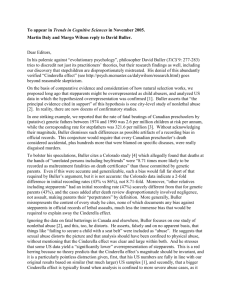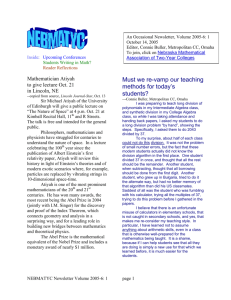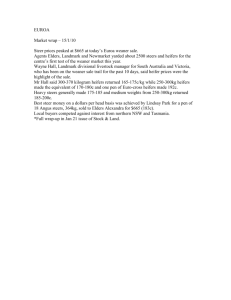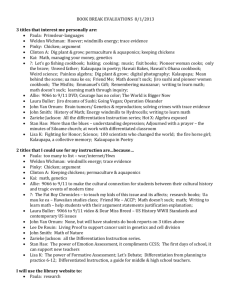Document 12087749
advertisement
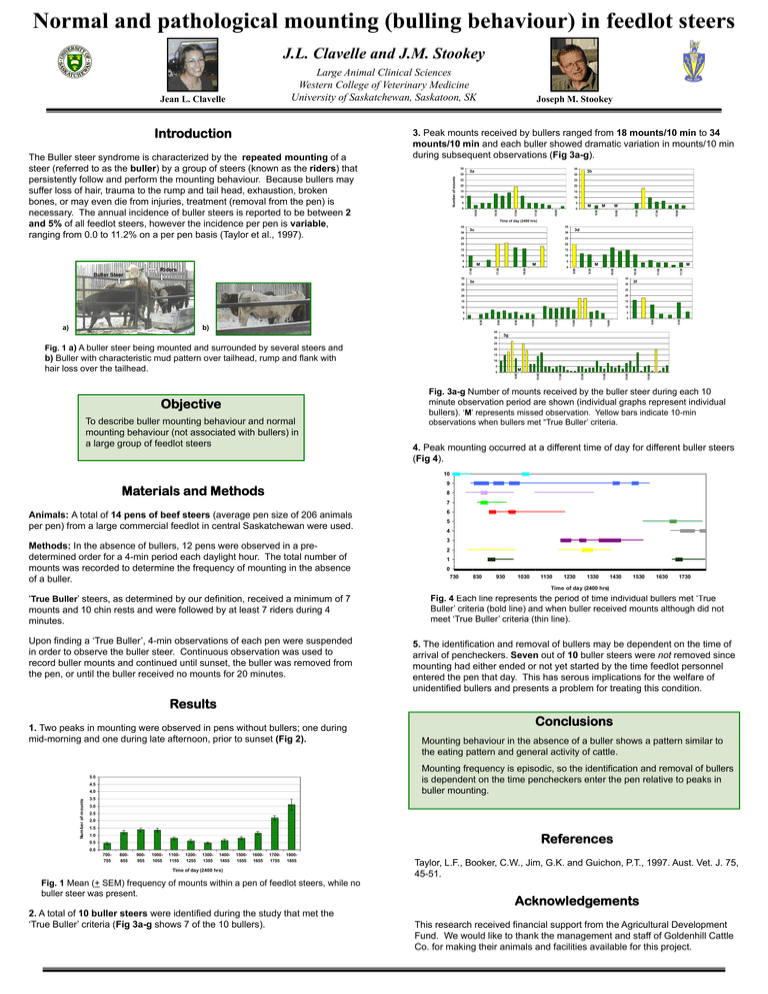
Normal and pathological mounting (bulling behaviour) in feedlot steers J.L. Clavelle and J.M. Stookey Large Animal Clinical Sciences Western College of Veterinary Medicine University of Saskatchewan, Saskatoon, SK 3. Peak mounts received by bullers ranged from 18 mounts/10 min to 34 mounts/10 min and each buller showed dramatic variation in mounts/10 min during subsequent observations (Fig 3a-g). 3b 30 10 10 5 5 0 0 M M M Time of day (2400 hrs) 20 15 15 10 10 0 18:00 M M 35 30 10 10 5 5 0 0 10:00 3f 14:00 15 13:30 15 13:00 20 12:30 20 9:30 25 9:00 25 8:30 b) 3e 9:30 30 35 9:00 Buller Steer 5 M 17:30 Riders 17:00 0 M 11:30 20 11:00 25 10:30 25 3d 10:00 30 9:30 30 35 3c 9:00 35 5 35 30 3g 25 Fig. 1 a) A buller steer being mounted and surrounded by several steers and 20 15 b) Buller with characteristic mud pattern over tailhead, rump and flank with hair loss over the tailhead. 10 5 15:00 14:00 13:00 12:00 11:00 M 10:00 0 9:00 a) 18:00 15 17:30 15 17:00 20 18:00 20 17:30 25 17:00 25 10:00 30 35 3a 9:30 35 16:30 The Buller steer syndrome is characterized by the repeated mounting of a steer (referred to as the buller) by a group of steers (known as the riders) that persistently follow and perform the mounting behaviour. Because bullers may suffer loss of hair, trauma to the rump and tail head, exhaustion, broken bones, or may even die from injuries, treatment (removal from the pen) is necessary. The annual incidence of buller steers is reported to be between 2 and 5% of all feedlot steers, however the incidence per pen is variable, ranging from 0.0 to 11.2% on a per pen basis (Taylor et al., 1997). Joseph M. Stookey 16:00 Introduction Number of mounts Jean L. Clavelle Fig. 3a-g Number of mounts received by the buller steer during each 10 minute observation period are shown (individual graphs represent individual bullers). ‘M’ represents missed observation. Yellow bars indicate 10-min Objective To describe buller mounting behaviour and normal mounting behaviour (not associated with bullers) in a large group of feedlot steers observations when bullers met “True Buller’ criteria. 4. Peak mounting occurred at a different time of day for different buller steers (Fig 4). 10 9 Materials and Methods 8 7 Animals: A total of 14 pens of beef steers (average pen size of 206 animals per pen) from a large commercial feedlot in central Saskatchewan were used. Methods: In the absence of bullers, 12 pens were observed in a predetermined order for a 4-min period each daylight hour. The total number of mounts was recorded to determine the frequency of mounting in the absence of a buller. 6 5 4 3 2 1 0 730 830 930 1030 1130 1230 1330 1430 1530 1630 1730 Time of day (2400 hrs) ‘True Buller’ steers, as determined by our definition, received a minimum of 7 mounts and 10 chin rests and were followed by at least 7 riders during 4 minutes. Upon finding a ‘True Buller’, 4-min observations of each pen were suspended in order to observe the buller steer. Continuous observation was used to record buller mounts and continued until sunset, the buller was removed from the pen, or until the buller received no mounts for 20 minutes. Fig. 4 Each line represents the period of time individual bullers met ‘True Buller’ criteria (bold line) and when buller received mounts although did not meet ‘True Buller’ criteria (thin line). 5. The identification and removal of bullers may be dependent on the time of arrival of pencheckers. Seven out of 10 buller steers were not removed since mounting had either ended or not yet started by the time feedlot personnel entered the pen that day. This has serous implications for the welfare of unidentified bullers and presents a problem for treating this condition. Results 1. Two peaks in mounting were observed in pens without bullers; one during mid-morning and one during late afternoon, prior to sunset (Fig 2). Mounting behaviour in the absence of a buller shows a pattern similar to the eating pattern and general activity of cattle. Mounting frequency is episodic, so the identification and removal of bullers is dependent on the time pencheckers enter the pen relative to peaks in buller mounting. 5.0 4.5 4.0 Num ber of m ounts Conclusions 3.5 3.0 2.5 2.0 1.5 References 1.0 0.5 0.0 700755 800855 900955 10001055 11001155 12001255 13001355 14001455 15001555 16001655 17001755 18001855 Time of day (2400 hrs) Fig. 1 Mean (+ SEM) frequency of mounts within a pen of feedlot steers, while no buller steer was present. 2. A total of 10 buller steers were identified during the study that met the ‘True Buller’ criteria (Fig 3a-g shows 7 of the 10 bullers). Taylor, L.F., Booker, C.W., Jim, G.K. and Guichon, P.T., 1997. Aust. Vet. J. 75, 45-51. Acknowledgements This research received financial support from the Agricultural Development Fund. We would like to thank the management and staff of Goldenhill Cattle Co. for making their animals and facilities available for this project.
